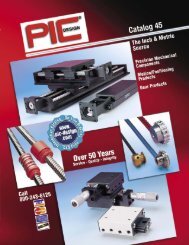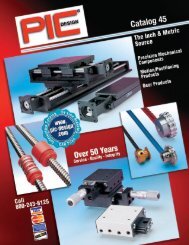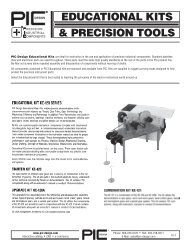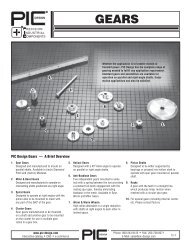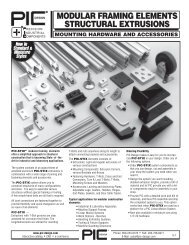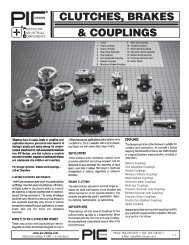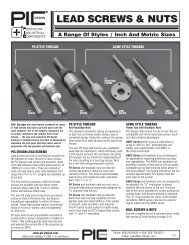Create successful ePaper yourself
Turn your PDF publications into a flip-book with our unique Google optimized e-Paper software.
TECHNICAL SECTION<br />
Whatever your application, <strong>PIC</strong> <strong>Design</strong> offers a linear motion component<br />
that will work for you. Determine all loads, magnitude and<br />
direction, force and torque for your system requirements. Use of this<br />
data should enable users to select individual components, then select<br />
and specify all parts from this comprehensive offering.<br />
END SUPPORTS VS. RAIL SUPPORT<br />
Knowing the load to be carried by the linear motion system will help<br />
determine the proper diameter of the shafts.<br />
By using the shaft deflection table below, you can estimate the amount<br />
each shaft will deflect at the center of the stroke under maximum load.<br />
If deflection must be minimized, a continuous or intermittent support<br />
rail should be used.<br />
BEARING SPEEDS<br />
Linear bearing systems using recirculating ball bearings can travel at<br />
about 250 ft./min.; ceramic coated bearings at about 400 ft./min.; and<br />
our <strong>PIC</strong> self-lubricating linear bearing at 200 ft./min.<br />
SHAFT HARDNESS<br />
Rockwell 55 to 60C is required for “no grooving” of the shaft when<br />
using recirculating ball bearings or ceramic coated bearings. Use our<br />
<strong>PIC</strong> C1060 hardened and ground steel shaft; or where application<br />
dictates, 440 C stainless steel hardened and ground shaft. <strong>PIC</strong> self-lube<br />
linear bearings can be used with above shafting as well as the more<br />
economical and corrosion resistant “soft” 303 stainless steel (Rockwell<br />
70-95B).<br />
LINEAR MOTION GUIDES (See <strong>Section</strong> 2 — Linear Slides)<br />
These guides offer excellent positioning accuracy, low friction, high load<br />
bearing capabilities and greater compactness with recirculating ball or<br />
crossed roller slide design.<br />
LUBRICATION<br />
In applications where operating speeds are low and loads are light,<br />
linear recirculating ball bearings can be used without lubrication.<br />
However, to protect the highly polished bearing surfaces from corrosion<br />
and wear, a lubricant is recommended for most applications.<br />
Use light oil for good surface adhesion and greater bearing protection.<br />
Shaft Deflection Table For Use In <strong>Design</strong> And Application Of Linear Motion Devices<br />
Basic Dynamic Load Rating (C)<br />
This term means such load that, when a certain number of identical<br />
linear systems are individually run in the same conditions, 90% of them<br />
can run with the load (with a constant value in a constant direction) for<br />
a distance of 50 x 10 3 meters without damage caused by rolling fatigue.<br />
Static Safety Factor (fs)<br />
This factor is used to derate the basic static load (Co) for the sake of<br />
safety, depending on the conditions of use as shown in Table 1.<br />
Table 1. Static Safety Factors<br />
Condition of use<br />
Low limit of fs<br />
When in regular<br />
operating condition 1~2<br />
When especially smooth running<br />
performance is needed 2~4<br />
When the equipment is subject<br />
to vibration and shock 3~5<br />
Basic Static Load Rating (Co)<br />
This term defines a static load such that, at the contacting position<br />
where the maximum stress is exercised, the sum of the permanent<br />
deformation of the rolling body and that of the rolling plane is 0.0001<br />
time of the diameter of the rolling body.<br />
Rating Life (L)<br />
Rating life is the total travelling distance that 90% of a group of linear<br />
systems of the same size can reach without causing any flaking when<br />
they operate under the same conditions.<br />
The rating life can be obtained from the following equation with the<br />
basic dynamic load rating and the load on the linear system:<br />
C<br />
P<br />
C<br />
P<br />
For ball type: L = ( —— ) 3 ● 50<br />
For roller type: L = ( —— ) 10/ 3 ● 50<br />
L: Rating life (km) C: Basic Dynamic load rating (kgf)<br />
P: Load (kgf)<br />
4-2<br />
Phone: 800-243-6125 ■ FAX: 203-758-8271<br />
E-Mail: sales@pic-design.com<br />
DESIGN<br />
®<br />
www.pic-design.com<br />
Interactive catalog ■ CAD ■ e-commerce



